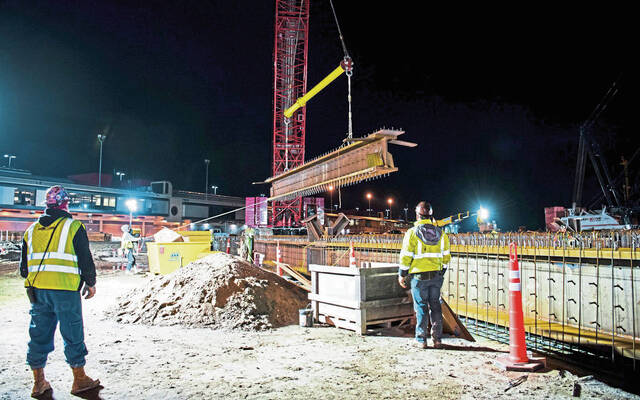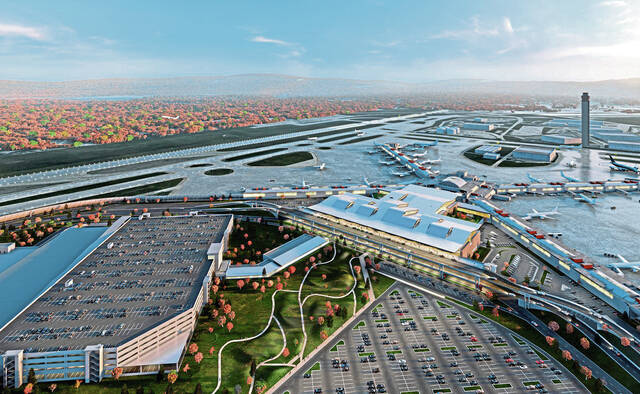Landside terminal construction underway at Pittsburgh International Airport
Cranes and construction crews are making headway at Pittsburgh International Airport, as work building a new landside terminal is well underway. Airport officials said progress for the $1.3 billion project is on schedule and the new, upgraded terminal is on track to open by 2025.
In fact, Allegheny County Airport Authority Chief Development Officer Paul Hoback said current passengers at the airport will probably see the construction while waiting for flights.
“You can start to see the cranes in place as you come onto the property. And from concourse C and D, you can watch all the construction that is going on out there,” Hoback said. “It is pretty exciting to see.”
Hoback said about 120 crew members are working on the site, building the foundation for the massive 700,000-square-foot terminal. He said they are about 50% done with foundation work, and then vertical construction — such as beams and steel columns — should begin in May.
The new landside terminal will be between the existing terminal and the gates. It will eliminate the need for the airport’s people mover train and long-range baggage transport because it will abut the existing structure that houses the gates. The design includes high ceilings and walls of windows to let in more natural light. The large space will include ticketing, baggage claim, and security checkpoints, as well as additional concessions, public art and green plazas just outside of the terminal.
Placing the new terminal right against the gates is about creating a modern design for Pittsburgh International Airport, Hoback said, and it moves away from when the airport was designed around being a hub for US Airways. The airport saw the decline of its hub status in the early 2000s, and air traffic declined dramatically for about a decade. Traffic has rebounded, but not to hub levels.
Hoback said, during its peak, the project will provide 1,500 construction jobs, 14,000 direct and indirect jobs total, and $2.5 billion in economic activity.
Setting the foundation
Hoback said crews are drilling 131 caissons on the site. Shafts will be inserted into those deep holes and hit the bedrock under the terminal.
Nearly all the caissons are drilled, Hoback said, and crews are placing 50-ton steel girders for the main foundation of the new terminal. These girders are 80 feet long and are manufactured at Sippel Steel in Ambridge.
Placement sometimes requires the airport to shut down the people mover for short periods of time, but Hoback said they already have completed this once with bus transports. He added that closing down the people mover only happens late at night and usually only affects passengers arriving on late-night flights.
There will be a total of 25 steel girders placed on the site, and only three of them are placed over the people-mover tunnels. Placing those three requires brief train closures.
“What’s great about how we are building this project is there are very few, minimal impacts on the day-to-day impacts on the airport,” Hoback said.
Vertical construction
Cranes already are on site, and, in less than two months, passengers and drivers approaching the airport should start to see the skeleton of the new landside terminal rise from the earth.
Hoback said the terminal’s gigantic steel beams that are split at the top to look like trees — known as “tree columns” — should be erected starting in May. Additional vertical construction of the terminal’s exterior will follow suit.
And, in April, construction will begin on the multimodal center to the northwest of the new terminal. It will include rental car facilities, new roadways and a 3,300-space parking garage. Crushed and recycled concrete from demolition of some current facilities will be used as part of the construction of the multimodal center, said Hoback.
All of the new facilities will be powered by five onsite natural gas generators and 9,000 solar panels that were built on top of a nearby landfill. The new power grid already has been brought online, and the main electrical grid will serve as backup in emergencies.
“Our entire airport is off the grid as of last June,” said Hoback.
Ryan Deto is a TribLive reporter covering politics, Pittsburgh and Allegheny County news. A native of California’s Bay Area, he joined the Trib in 2022 after spending more than six years covering Pittsburgh at the Pittsburgh City Paper, including serving as managing editor. He can be reached at rdeto@triblive.com.
Remove the ads from your TribLIVE reading experience but still support the journalists who create the content with TribLIVE Ad-Free.



